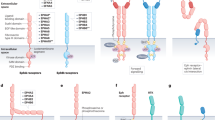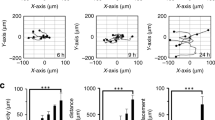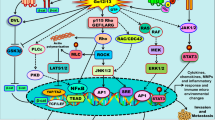Abstract
Signalling through G-protein-coupled receptors (GPCRs) and receptor tyrosine kinases (RTK) is involved in the regulation of essential cellular processes and its deregulation is associated with tumorigenesis in vitro and in vivo. We investigated pathophysiological processes that are regulated by GPCR pathways in human kidney and bladder cancer cell lines. Our results show that GPCR ligands induce tyrosine phosphorylation of the epidermal growth factor receptor (EGFR) as well as downstream signalling events such as recruitment of the adapter protein Shc and activation of the mitogen-activated protein kinases (MAPK) ERK1/2, JNK and p38. Moreover, we report that the EGFR transactivation signal involves the EGFR ligands amphiregulin, HB-EGF and TGFα as well as the metalloproteinases ADAM 10, 15 and 17, depending on the cellular system. Finally, we demonstrate that EGFR transactivation is part of a regulatory system that modulates the migratory and invasive behaviour of kidney and bladder cancer cells. In conclusion, our findings demonstrate that metalloproteinase-mediated transactivation of the EGFR is a key mechanism of the cellular signalling network that promotes MAPK activation as well as tumour cell migration and invasion in response to a variety of physiologically relevant GPCR ligands, and therefore represents a novel target for cancer intervention strategies.
This is a preview of subscription content, access via your institution
Access options
Subscribe to this journal
Receive 50 print issues and online access
$259.00 per year
only $5.18 per issue
Buy this article
- Purchase on Springer Link
- Instant access to full article PDF
Prices may be subject to local taxes which are calculated during checkout




Similar content being viewed by others
Abbreviations
- DMSO:
-
dimethylsulphoxide
- EGFR:
-
epidermal growth factor receptor
- ERK:
-
extracellular signal-regulated kinase
- GPCR:
-
G-protein-coupled receptor
- HB-EGF:
-
heparin-binding EGF-like growth factor
- JNK:
-
c-jun N-terminal kinase
- LPA:
-
lysophosphatidic acid
- MAPK:
-
mitogen-activated protein kiase
- RTK:
-
receptor tyrosine kinase
References
Bue P, Wester K, Sjostrom A, Holmberg A, Nilsson S, Carlsson J, Westlin JE, Busch C and Malmstrom PU . (1998). Int. J. Cancer, 76, 189–193.
Daub H, Weiss FU, Wallasch C and Ullrich A . (1996). Nature, 379, 557–560.
De Boer WI, Houtsmuller AB, Izadifar V, Muscatelli-Groux B, Van der Kwast TH and Chopin DK . (1997). Int. J. Cancer, 71, 284–291.
Dempsey PJ, Meise KS, Yoshitake Y, Nishikawa K and Coffey RJ . (1997). J. Cell Biol., 138, 747–758.
Dong J, Opresko LK, Dempsey PJ, Lauffenburger DA, Coffey RJ and Wiley HS . (1999). Proc. Natl. Acad. Sci. USA, 96, 6235–6240.
Elbashir SM, Harborth J, Lendeckel W, Yalcin A, Weber K and Tuschl T . (2001). Nature, 411, 494–498.
Gerthoffer WT, Yamboliev IA, Shearer M, Pohl J, Haynes R, Dang S, Sato K and Sellers JR . (1996). J. Physiol., 495, 597–609.
Ghanem MA, Van Der Kwast TH, Den Hollander JC, Sudaryo MK, Mathoera RB, Van den Heuvel MM, Noordzij MA, Nijman RJ and van Steenbrugge GJ . (2001). Cancer, 92, 3120–3129.
Gildea JJ, Harding MA, Seraj MJ, Gulding KM and Theodorescu D . (2002). Cancer Res., 62, 982–985.
Gill GN, Bertics PJ and Santon JB . (1987). Mol. Cell. Endocrinol., 51, 169–186.
Gschwind A, Hart S, Fischer OM and Ullrich A . (2003). EMBO J., 22, 2411–2421.
Gschwind A, Prenzel N and Ullrich A . (2002). Cancer Res., 62, 6329–6336.
Ishikawa J, Maeda S, Sugiyama T, Nishimura R, Mizoguchi A and Kamidono S . (1989). Int. J. Cancer, 44, 1000–1004.
Kinsella TM and Nolan GP . (1996). Hum. Gene Ther., 7, 1405–1413.
Levine JS, Koh JS, Triaca V and Lieberthal W . (1997). Am. J. Physiol., 273, F575–F585.
Lummen G, Virchow S, Rumenapp U, Schmidt M, Wieland T, Otto T, Rubben H and Jakobs KH . (1997). Naunyn-Schmiedeberg's Arch. Pharmacol., 356, 769–776.
McCole DF, Keely SJ, Coffey RJ and Barrett KE . (2002). J. Biol. Chem., 277, 42603–42612.
Normanno N, Bianco C, De Luca A, Maiello MR and Salomon DS . (2003). Endocr. Relat. Cancer, 10, 1–21.
Pai R, Soreghan B, Szabo IL, Pavelka M, Baatar D and Tarnawski AS . (2002). Nat. Med., 8, 289–293.
Prenzel N, Zwick E, Daub H, Leserer M, Abraham R, Wallasch C and Ullrich A . (1999). Nature, 402, 884–888.
Ritter CA and Arteaga CL . (2003). Semin. Oncol., 30, 3–11.
Ruck A and Paulie S . (1997). Anticancer Res., 17, 1925–1931.
Ruck A and Paulie S . (1998). Anticancer Res., 18, 1447–1452.
Sieuwerts AM, Klijn JG and Foekens JA . (1997). Clin. Exp. Metastasis, 15, 53–62.
Sunnarborg SW, Hinkle CL, Stevenson M, Russell WE, Raska CS, Peschon JJ, Castner BJ, Gerhart MJ, Paxton RJ, Black RA and Lee DC . (2002). J. Biol. Chem., 277, 12838–12845.
Uchiyama-Tanaka Y, Matsubara H, Nozawa Y, Murasawa S, Mori Y, Kosaki A, Maruyama K, Masaki H, Shibasaki Y, Fujiyama S, Nose A, Iba O, Hasagawa T, Tateishi E, Higashiyama S and Iwasaka T . (2001). Kidney Int., 60, 2153–2163.
Van Brussel JP and Mickisch GH . (1999). BJU Int., 83, 902–908, quiz 908-9.
Vogelzang NJ and Stadler WM . (1998). Lancet, 352, 1691–1696.
Wallasch C, Crabtree JE, Bevec D, Robinson PA, Wagner H and Ullrich A . (2002). Biochem. Biophys. Res. Commun., 295, 695–701.
Wetzker R and Bohmer FD . (2003). Nat. Rev. Mol. Cell Biol., 4, 651–657.
Xu Y, Gaudette DC, Boynton JD, Frankel A, Fang XJ, Sharma A, Hurteau J, Casey G, Goodbody A and Mellors A . (1995). Clin. Cancer Res., 1, 1223–1232.
Yan Y, Shirakabe K and Werb Z . (2002). J. Cell Biol., 158, 221–226.
Yarden Y . (2001). Oncology, 61, 1–13.
Zwick E, Hackel PO, Prenzel N and Ullrich A . (1999). Trends Pharmacol. Sci., 20, 408–412.
Acknowledgements
We would like to thank Dr Klaus Maskos (Martinsried) for providing batimastat, Stefan Hart for generating the stable A498 clones and Beatrice Marg for carefully reading the manuscript.
Author information
Authors and Affiliations
Corresponding author
Rights and permissions
About this article
Cite this article
Schäfer, B., Gschwind, A. & Ullrich, A. Multiple G-protein-coupled receptor signals converge on the epidermal growth factor receptor to promote migration and invasion. Oncogene 23, 991–999 (2004). https://doi.org/10.1038/sj.onc.1207278
Received:
Revised:
Accepted:
Published:
Issue Date:
DOI: https://doi.org/10.1038/sj.onc.1207278
Keywords
This article is cited by
-
Connecting G protein-coupled estrogen receptor biomolecular mechanisms with the pathophysiology of preeclampsia: a review
Reproductive Biology and Endocrinology (2023)
-
Particulate matter promotes cancer metastasis through increased HBEGF expression in macrophages
Experimental & Molecular Medicine (2022)
-
Contribution of ADAM17 and related ADAMs in cardiovascular diseases
Cellular and Molecular Life Sciences (2021)
-
8-Ethynylxanthines as promising antiproliferative agents, angiogenesis inhibitors, and calcium channel activity modulators
Chemistry of Heterocyclic Compounds (2020)
-
Ambrisentan, an endothelin receptor type A-selective antagonist, inhibits cancer cell migration, invasion, and metastasis
Scientific Reports (2020)



